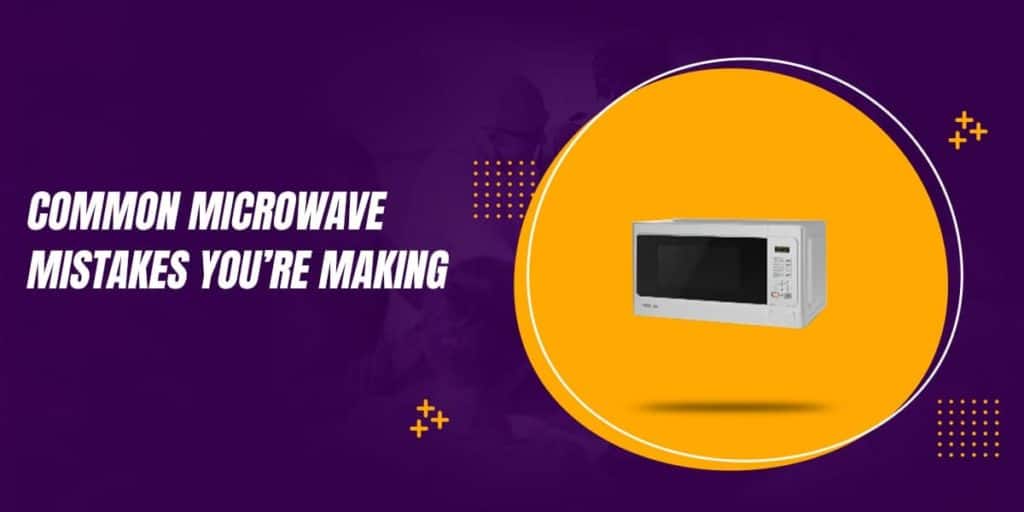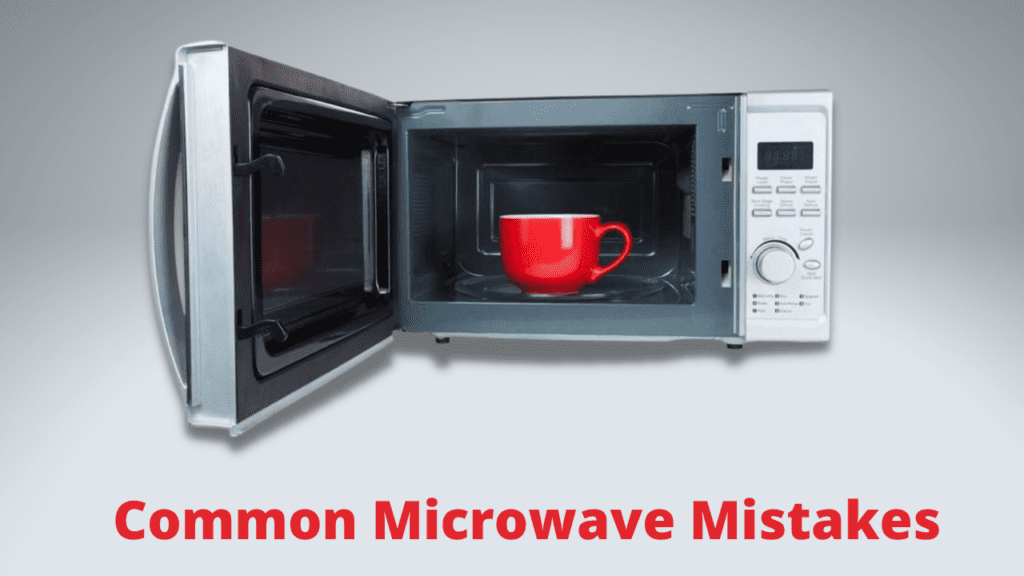Contents

Looking to know what are the Common Microwave Mistakes? Read further to know more about it.
One thing’s certain. A microwave is one such kitchen appliance we cannot function without today. So yes, using it the right way is the need of the hour.
It’s perhaps one of the handiest appliances in our kitchens, and it’s pretty straightforward to use, right? But there are some common mistakes you might be making that are putting your microwave game off. Our experts put microwave etiquette under the microscope to help you fix any missteps.
Common Microwave Mistakes
1. Putting your Microwave in the wrong place
Most modern kitchens have a dedicated spot for the microwave – hidden behind built-in cabinetry for example, or under a benchtop – and where it’s best placed depends on how much you use it and how easily accessible it is.
Do you have it out on the bench so you can easily get to it every morning (but where it takes up valuable space?), or do you have it hidden in the pantry where you barely use it and forget that it’s there?
You should also ensure your microwave door closes correctly with a good seal to reduce the risk of leakage and to improve its performance.
2. Not covering your food
Ever unwittingly put something in the microwave for a quick nuke only to find a food apocalypse at the end? Yeah, it’s happened to us all at some point.
A simple fix for food explosions is to always cover your food with a lid, microwave-safe plastic wrap, or paper.
CHOICE expert Fiona Mair adds that placing a lid on your food can also better assist with cooking “because it helps to hold moisture and even out heat distribution”.
3. Not cleaning it properly
Are you guilty of leaving spillage or splatter in your microwave, promising yourself you’ll clean it up later? It’s a big no-no.
“Leaving food splatters in your microwave will slow down the cooking time as it cooks the residue as well as the intended food,” says Fiona. Not to mention, it just looks gross.
So, clean up any spills ASAP by wiping up with warm soapy water. If there is built-up grime and grease, Fiona suggests popping a few slices of lemon in a bowl of water into the microwave on high for two minutes. Then simply wipe the interior with a microfibre cloth.

4. Buying the wrong type of microwave
The good ol’ microwave has come a long way since its invention in the 1940s. Many now come with a huge variety of features including ‘sensor cooking’, which automatically controls the cooking time, and presets that allow you to do everything from roasting a whole chicken to (apparently) cooking perfect popcorn.
With so many brands and models on the market at different price points, it can be tricky choosing the right one for you. Our experts have reviewed almost 40 different conventional microwave models (plus more convection models) to help you make the right choice.
And there are a few budget options that outperform models that are much more expensive, so it’s a good idea to check our expert reviews before you buy.
The simplest way to avoid food explosions is to always cover your food with a lid, microwave-safe plastic wrap, or paper.
5. Not defrosting meat correctly
It’s one of the main reasons we use our microwaves, but we often get it so wrong! There’s nothing worse than ending up with partially frozen, partially cooked meat.
Some microwaves have automatic defrost settings so the guesswork is taken away: you enter the weight of the food and it will set the required defrost time for you.
Some microwaves will also beep mid-cycle so you can check on the meat, and CHOICE expert Rebecca Ciaramidaro warns us not to ignore this:
“It’s your signal to turn the meat over and remove any sections that are already thawed out before they cook,” says Rebecca. She also suggests you “freeze meat in smaller quantities to make defrosting more efficient”.
We know defrosting is something many people use their microwaves for, so our experts take this into account when giving each microwave we test a CHOICE Expert Rating.
We score each microwave on how well it defrosts meat and a whole chicken, so if this matters to you, check our reviews before you buy.
6. Putting hazardous packaging in the microwave
This is a common no-no. Plastic packaging (such as the packaging your meat comes in) and Styrofoam takeaway containers should never be placed in the microwave as these materials can leak chemicals and contaminate your food. And metal, aluminum foil and paper bags are hazardous as they can cause a fire.
Check your storage containers are microwave safe (this is usually indicated on the bottom of the container), otherwise they can warp or melt and release chemicals into your food.
Fiona also warns that some microwave-safe containers are only suitable for reheating, not cooking or boiling.
7. Only using it to reheat and defrost
Many of us still use our microwaves to simply reheat last night’s takeaway or defrost meat for tonight’s dinner, but there’s so much more to this essential kitchen appliance – from cooking vegetables to roasting a chicken to baking a cake.
Before you get busy in the kitchen, check out these microwave cooking tips and 10 easy microwave hacks (including how to cook perfect rice, every time, and how to make your heat pack).
“The best advice is to read your microwave’s instruction manual. You will be amazed at what it can do to save you time in the kitchen,” says Fiona.
8. Using incorrect power settings
Do you just punch buttons on your microwave when cooking or reheating and hope for the best? CHOICE expert Rebecca says that using correct power settings for different foods will give you better results.
And if you don’t select a power setting, it will just default to ‘High’. She warns against using the ’30-second button’ to quickly reheat food, as it will use the highest power setting and won’t heat all food types evenly.
“It’s best to use a lower power level when reheating foods; it may take longer but you’ll get a better result.” And, if you’re doing something such as softening butter or ice cream, or proving dough, a low setting is all you need. Find out about different microwave settings and which ones to use.
Another handy hint: if you replace your microwave with a newer model, chances are you’ll need to reduce cooking times, so check the manual before throwing a roast on.
We all know that it is a time-saving and easy way to cook food, but there are some common mistakes which we make while using it.
Microwave food that is hard to heat If you are preparing some food that is difficult to cook or it takes a long time then don’t waste your time by putting it in the microwave.
It is better to take out the food from the microwave oven and cook it in the pan. If the food is not cooked properly then it will give a bad smell and taste. So, don’t do it.
Microwaving food in a closed container If you want to keep the food hot for a long time then make sure that you are not keeping it in a closed container.
Putting the food into the microwave oven Don’t put the food in the microwave oven as it may lead to burning your food. If you want to cook some food then first cut it into small pieces.
Microwaving more than one item at a time is a common mistake that many people do. If you are cooking two or more items then don’t put them in the microwave at a time. This may lead to overheating and damage your food.
Microwaving food that has been opened Never microwave food that has been opened. It will give a bad smell and taste to your food. If you are going to eat the food after opening then open the container again before microwaving.
Microwaving food without water When you are preparing food, always add a little bit of water to the food. It will help to prevent the food from getting burnt.
Microwaving the food for a long time Don’t microwave your food for a long time. You should know that it will take time to cook the food. So, keep an eye on the time. If the time is less than 1 minute then don’t put the food in the microwave.
Microwaving frozen food needs to be thawed and then cooked. But if you microwave the frozen food then it will not get cooked. So, always defrost the frozen food before cooking.
Microwaving food without measuring It is a common mistake that many people make. They just don’t know how much oil they are putting in the food. If you are using too much oil then it will take more time to cook the food. So, measure the oil before you start cooking.
Microwaving too often is a common mistake that many people do. It will lead to overheating your food. If you are planning to microwave your food then first defrost it and then cook it.
Don’t microwave it for a too long time as it will lead to a bad smell and taste. Conclusion: These are some of the most common mistakes that we do while using the microwave oven. So, don’t make them again.
